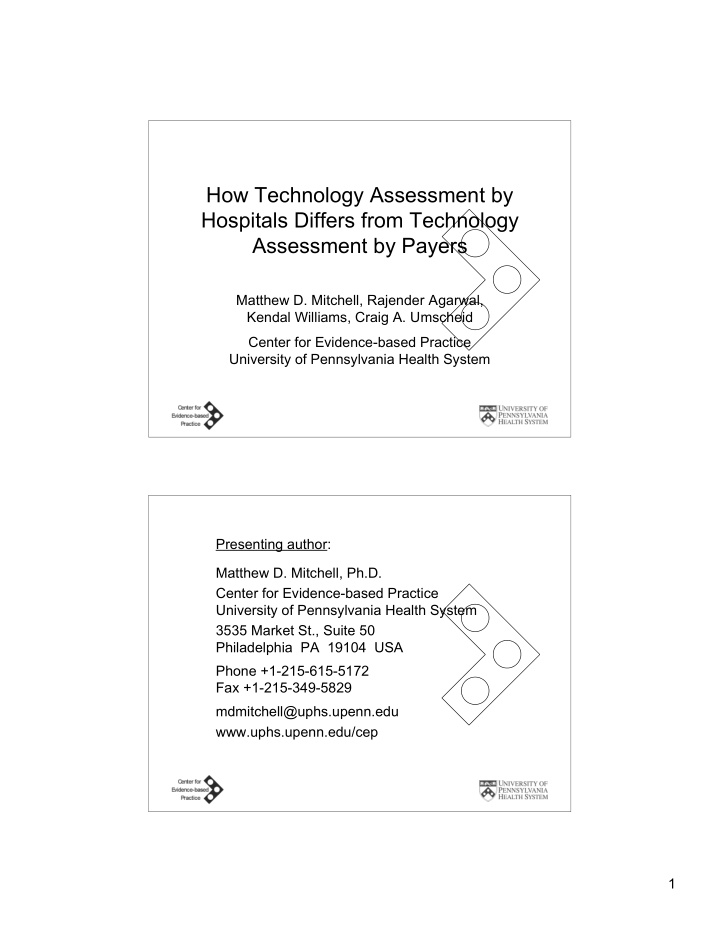



How Technology Assessment by Hospitals Differs from Technology Assessment by Payers Matthew D. Mitchell, Rajender Agarwal, Kendal Williams, Craig A. Umscheid Center for Evidence-based Practice University of Pennsylvania Health System Presenting author: Matthew D. Mitchell, Ph.D. Center for Evidence-based Practice University of Pennsylvania Health System 3535 Market St., Suite 50 Philadelphia PA 19104 USA Phone +1-215-615-5172 Fax +1-215-349-5829 mdmitchell@uphs.upenn.edu www.uphs.upenn.edu/cep 1
Who uses technology assessment? Payers Industry Clinical specialty societies Regulatory agencies Hospitals The bulk of technology assessment is done by and for payers 2
Why do payers use TA? Emerging technologies Provider requests High-impact technologies High-cost technologies Screening and other services with potentially large numbers of users Quality and accountability Why do hospitals use TA? Decisions on technology acquisition Identifying and implementing best practices in processes of care Standardization of care Risk management and reduction Prioritizing quality improvement measures 3
Key differences between hospital and payer TA Topic selection Methods and analytic approach Involvement of clinicians Local perspective Pragmatic approach Focus on implementation CEP at UPHS Established 2006 2 co-directors 2 research analysts Various supporting personnel Reports to Chief Medical Officer Serves entire health system See poster #703 4
CEP functions Answer technology assessment questions from clinical departments Evaluate technologies for supply chain and pharmacy committees Assist CMO with quality improvement projects Also some non-hospital collaborations Guideline/policy topics Should central venous catheters be flushed with heparin or with saline? How should we manage transitions of care for patients on anticoagulant therapy? 5
Committee decision topics Is reprocessing of single-use devices safe and effective? Which patients should have telemetry? Should celecoxib be on the formulary for post-op use in hip replacement patients? Should aprotinin be on the formulary for adult cardiac surgery patients? Executive decision topics Should the hospital continue a contract for ICU telemedicine coverage? Is aprotinin safe for use in adult cardiac surgery? What manufacturer should supply new imaging equipment for a cardiac cath lab? Poster 793 6
Topics for outside partners Is there a valid clinical basis for treatment with IV hydrogen peroxide? (payer) What procedures should be used in hospitals to prevent catheter-associated urinary tract infection? (CDC) How many hospital-acquired infections are “reasonably preventable”? (SHEA) Hospital TA programs span a broader range of topics than payer TA programs 7
Hospital TA programs also use different methods than payer TA programs Methods: use publications that are most locally relevant Evidence from comparable institutions Evidence on comparable patient populations 8
Methods: use evidence generated in the hospital Local outcomes Characteristics of local patients Relationships among local specialists Local staff and equipment availability Local utilization patterns Variations in practice among local clinicians Methods: clinician involvement Selecting topics and refining questions Providing strategic & patient care context Reviewing initial evidence assessment Approval of resulting guidelines & policies Considerable involvement of nursing staff 9
Methods: highly pragmatic Assessments limited to questions that affect hospital decision-making Work from existing secondary sources when possible Use in-house data Summarize evidence for busy clinicians Draw conclusions with implementation in mind Hospital TA focuses on implementation Ensure implementing staff are involved in commissioning and reviewing report Prepare draft policies for review Standardized order sets Assess impact of TA process on patient care 10
Celecoxib Purpose Committee decision on formulary Resources Published literature Local factors Very specific clinical circumstances for use (post-op use in hip replacement patients) ICU Telemedicine Purpose Executive decision on contract renewal Resources Published literature (scarce) Mortality and LOS data from UPHS ICUs with and without telemedicine coverage Local factors Local circumstances of ICU staffing 11
Heparin Flush Purpose Standardize nursing practice guidelines for central venous catheter care Resources Published literature Local factors Collaboration with nursing leaders to acquire additional clinical evidence TA collaborations Broaden your topic list Look for process of care topics Build relationships with clinicians Physicians and nurses give clinical context Work pragmatically Look for reliable secondary sources to base conclusions on 12
TA collaborations Provide for localizing your findings Selecting evidence relevant to users’ practice Adding local outcomes and resource information Focus on implementation Develop tools like standard order sets Measure effect of TA process on patient care 13
Recommend
More recommend